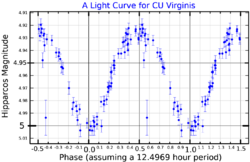Astronomy:CU Virginis
| Observation data Equinox J2000.0]] (ICRS) | |
|---|---|
| Constellation | Virgo |
| Right ascension | 14h 12m 15.80569s[2] |
| Declination | +02° 24′ 33.9342″[2] |
| Apparent magnitude (V) | 4.99[3] (4.92–5.07)[4] |
| Characteristics | |
| Spectral type | ApSi[5] or B8.5 Vp Si[6] |
| B−V color index | −0.118±0.006[3] |
| Variable type | α2 CVn[4] |
| Astrometry | |
| Radial velocity (Rv) | −2.0±7.4[7] km/s |
| Proper motion (μ) | RA: −43.049[2] mas/yr Dec.: +26.081[2] mas/yr |
| Parallax (π) | 13.9366 ± 0.2601[2] mas |
| Distance | 234 ± 4 ly (72 ± 1 pc) |
| Absolute magnitude (MV) | 0.50[3] |
| Details[8] | |
| Mass | 3.06±0.06 M☉ |
| Radius | 2.06±0.14 R☉ |
| Luminosity | 100±11 L☉ |
| Surface gravity (log g) | 4.30±0.06 cgs |
| Temperature | 12,750±250 K |
| Rotation | 0.5207137±0.0000010 d[9] |
| Rotational velocity (v sin i) | 145±3 km/s |
| Other designations | |
| Database references | |
| SIMBAD | data |
CU Virginis is a single[11] star in the equatorial constellation of Virgo.[12] It has an apparent visual magnitude of 4.99,[3] which is bright enough to be faintly visible to the naked eye. The distance to this star can be estimated from its annual parallax shift of 13.9 mas,[2] yielding a separation of 234 light years.
This is one of the best studied Ap stars.[13] It has a stellar classification of Ap Si[5] with strong lines of silicon and weak helium lines. The star is a fast rotator with a period of 0.52 days and an axis that is inclined by 46.5°±4.1° to the line of sight from the Earth.[8] Both the spectrum and luminosity of the star vary with the rotation,[13] and it is classified as a α2 Canum Venaticorum variable with the designation CU Virginis (CU Vir).[4] There is some evidence that the rotation period may vary slightly over a timescale measured in decades.[14] Such changes have been observed to occur in glitches, rather than varying constantly.[13]
CU Virginis has three times the mass of the Sun and double the Sun's radius. It is radiating 100 times the Sun's luminosity from its photosphere at an effective temperature of 12,750 K.[8] The star has a strong magnetic field, placing it in the class of magnetic chemically peculiar stars. The polar magnetic field has a strength of about 3 kG.[13] The magnetic pole may be displaced by 87° from the axis of rotation, and the effective magnetic field is seen to vary over the course of a rotation.[13] The mean surface magnetic field varies over the range 1.2–3.2 kG.[15]
This star is a radio emitter, with the emission being modulated by the rotational phase. This emission is believed to be gyrosynchrotron radiation emitted by mildly relativistic (Lorentz factor of γ ≤ 2) electrons trapped in the magnetosphere". Two pulses of 100% circularly polarized radio energy are detected each rotation, which may be produced via an electron cyclotron maser process. These polarized beams are then refracted as they pass through cold plasma in the star's magnetosphere.[13]
References
- ↑ "Light Curve". ESA. https://www.cosmos.esa.int/web/hipparcos/java-tools/light-curve.
- ↑ 2.0 2.1 2.2 2.3 2.4 2.5 Brown, A. G. A. (August 2018). "Gaia Data Release 2: Summary of the contents and survey properties". Astronomy & Astrophysics 616: A1. doi:10.1051/0004-6361/201833051. Bibcode: 2018A&A...616A...1G. Gaia DR2 record for this source at VizieR.
- ↑ 3.0 3.1 3.2 3.3 Anderson, E.; Francis, Ch. (2012), "XHIP: An extended hipparcos compilation", Astronomy Letters 38 (5): 331, doi:10.1134/S1063773712050015, Bibcode: 2012AstL...38..331A.
- ↑ 4.0 4.1 4.2 Samus', N. N; Kazarovets, E. V; Durlevich, O. V; Kireeva, N. N; Pastukhova, E. N (2017), "General catalogue of variable stars: Version GCVS 5.1", Astronomy Reports 61 (1): 80–88, doi:10.1134/S1063772917010085, Bibcode: 2017ARep...61...80S.
- ↑ 5.0 5.1 Houk, N.; Swift, C. (1999), "Michigan catalogue of two-dimensional spectral types for the HD Stars", Michigan Spectral Survey 5, Bibcode: 1999MSS...C05....0H.
- ↑ Abt, Helmut A.; Morrell, Nidia I. (1995), "The Relation between Rotational Velocities and Spectral Peculiarities among A-Type Stars", Astrophysical Journal Supplement 95: 135, doi:10.1086/192182, Bibcode: 1995ApJS...99..135A.
- ↑ Kharchenko, N. V. et al. (2007), "Astrophysical supplements to the ASCC-2.5: Ia. Radial velocities of ~55000 stars and mean radial velocities of 516 Galactic open clusters and associations", Astronomische Nachrichten 328 (9): 889, doi:10.1002/asna.200710776, Bibcode: 2007AN....328..889K.
- ↑ 8.0 8.1 8.2 Kochukhov, O. et al. (May 2014), "Magnetic field topology of the unique chemically peculiar star CU Virginis", Astronomy & Astrophysics 565: 14, doi:10.1051/0004-6361/201423472, A83, Bibcode: 2014A&A...565A..83K.
- ↑ Pyper, Diane M. et al. (May 2013), "An update on the rotational period of the magnetic chemically peculiar star CU Virginis", Monthly Notices of the Royal Astronomical Society 431 (3): 2106–2110, doi:10.1093/mnras/stt256, Bibcode: 2013MNRAS.431.2106P.
- ↑ "HD 124224". SIMBAD. Centre de données astronomiques de Strasbourg. http://simbad.u-strasbg.fr/simbad/sim-basic?Ident=HD+124224.
- ↑ Eggleton, P. P.; Tokovinin, A. A. (2008), "A catalogue of multiplicity among bright stellar systems", Monthly Notices of the Royal Astronomical Society 389 (2): 869, doi:10.1111/j.1365-2966.2008.13596.x, Bibcode: 2008MNRAS.389..869E.
- ↑ Kaler, James B. (May 23, 2014), "CU Virginis", Stars (University of Illinois), http://stars.astro.illinois.edu/sow/cuvir.html, retrieved 2018-08-18.
- ↑ 13.0 13.1 13.2 13.3 13.4 13.5 Lo, K. K. et al. (April 2012), "Observations and modelling of pulsed radio emission from CU Virginis", Monthly Notices of the Royal Astronomical Society 421 (4): 3316–3324, doi:10.1111/j.1365-2966.2012.20555.x, Bibcode: 2012MNRAS.421.3316L.
- ↑ Mikulášek, Z. et al. (October 2011), "Surprising variations in the rotation of the chemically peculiar stars CU Virginis and V901 Orionis", Astronomy & Astrophysics 534: 5, doi:10.1051/0004-6361/201117784, L5, Bibcode: 2011A&A...534L...5M.
- ↑ Glagolevskij, Yu. V.; Gerth, E. (February 2002), "Comments on the magnetic field structure of the star CU Virginis", Astronomy and Astrophysics 382 (3): 935–938, doi:10.1051/0004-6361:20011629, Bibcode: 2002A&A...382..935G.
 |


